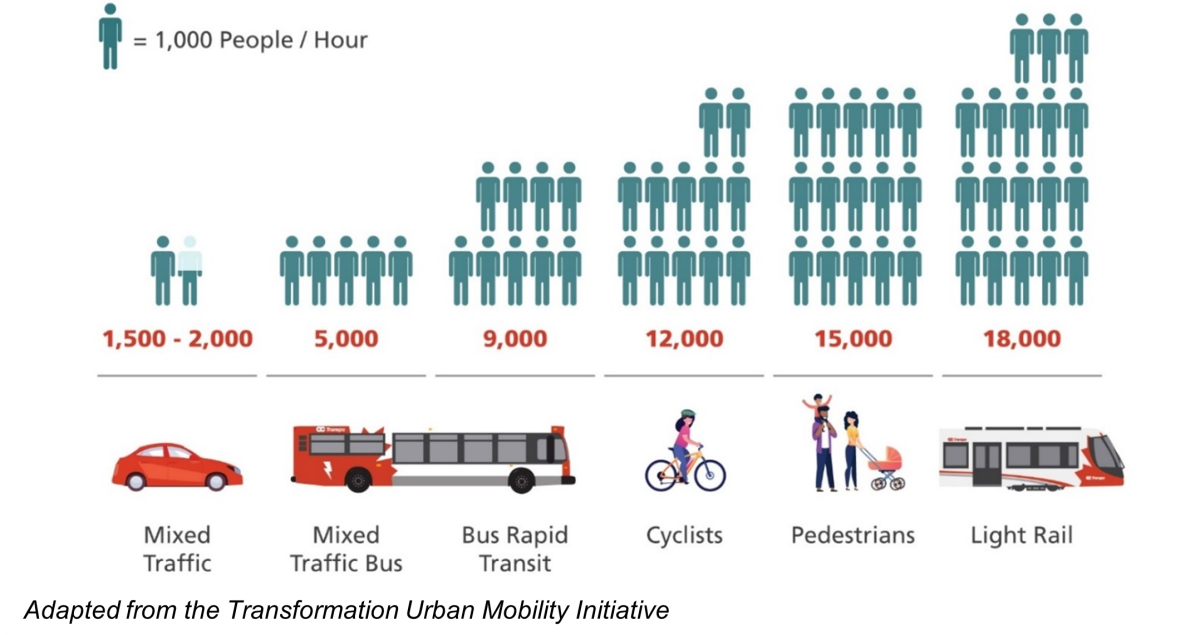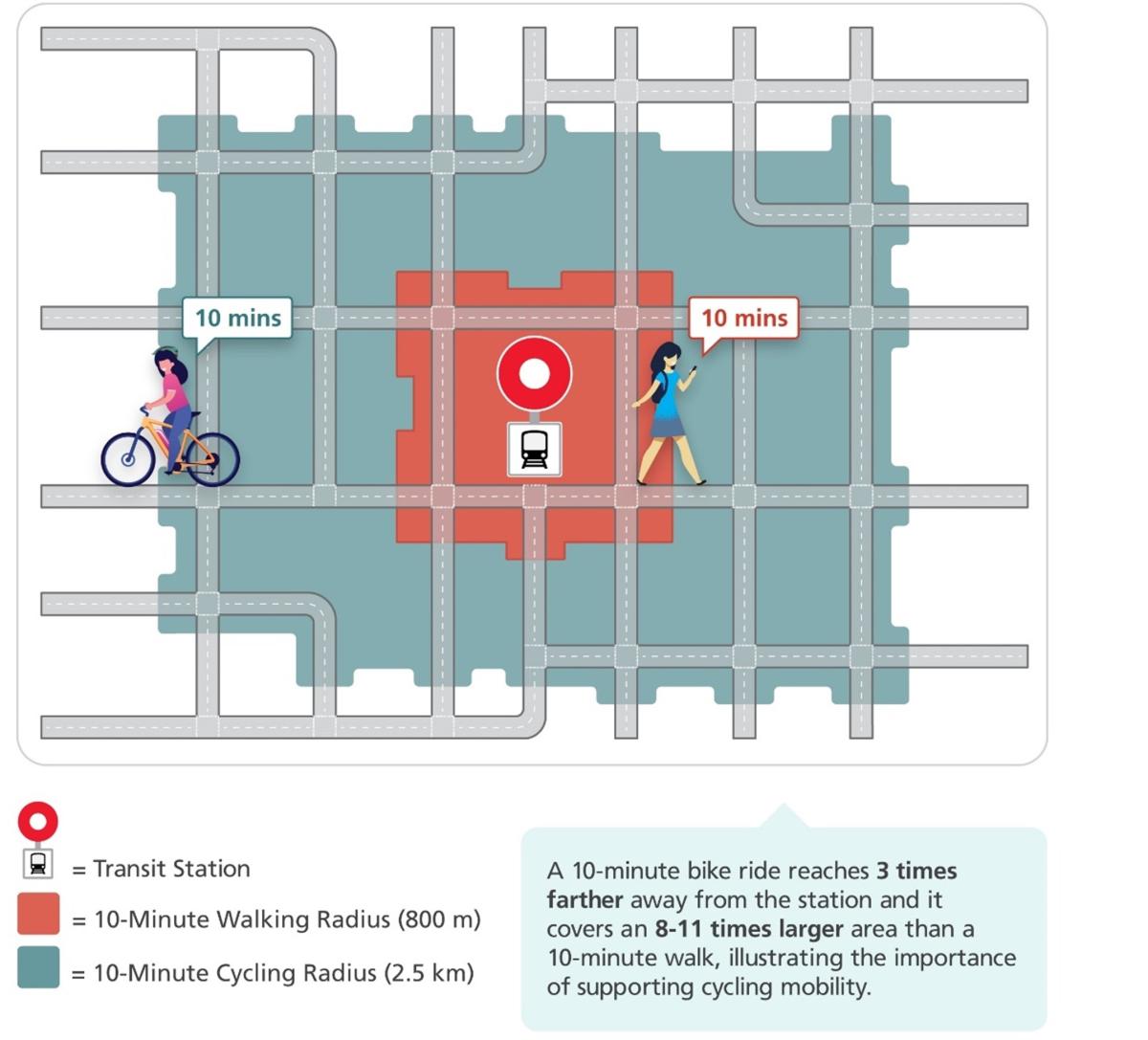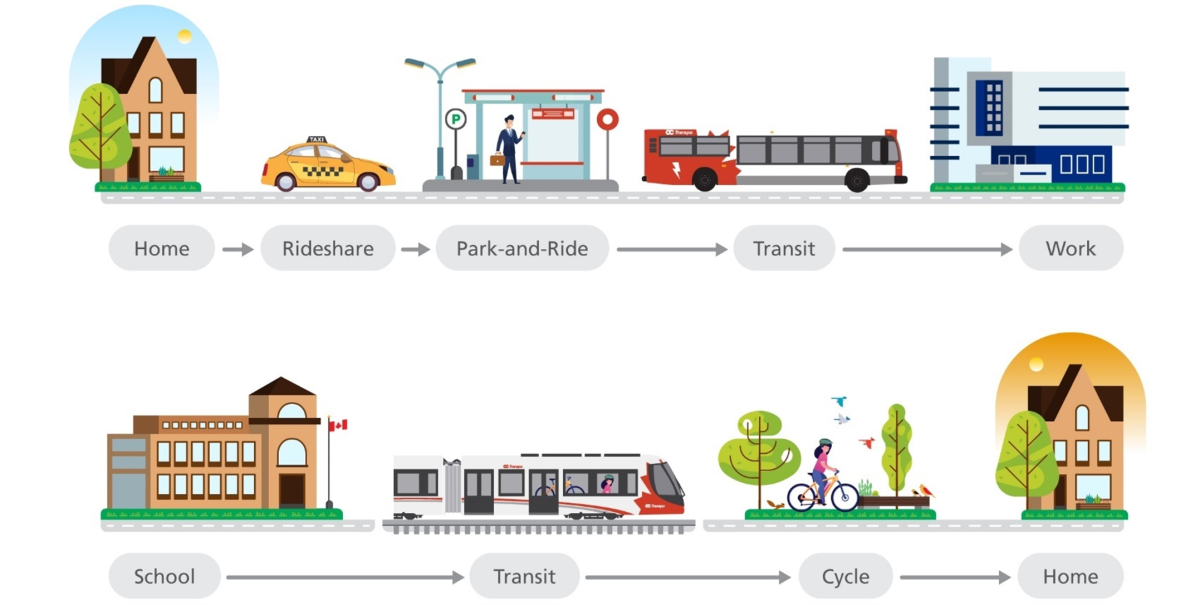By David Forsey (Associate Principal – Practice Lead, Transportation Engineering, Arcadis) and David Pau (Transportation Planner, Arcadis)
The City of Ottawa has set a goal to become North America’s most liveable mid-sized city. To help realize this vision, the City has set a goal for most trips to be made using sustainable transportation modes (walking, cycling, transit or carpooling) by 2046.
Extensive work is already underway to meet this goal. Since 2013, the City has built the spine of the O-Train system and supported intensification along transit corridors. “Complete Streets” are being implemented in several places, and the City is preparing for future technologies like connected, autonomous, and electric vehicles. Despite this progress, significant challenges remain. Ottawa, like many cities, is facing a climate emergency amidst significant uncertainty about post-pandemic lifestyles and travels. Affordability is a growing concern and there is an increasing need to continue improving health, safety, accessibility, and equity.
The question at hand is how can Ottawa’s mobility system be planned, developed, and operated to meet the needs of the City from today to 2046?
To answer this question, Ottawa is updating its Transportation Master Plan (TMP): a document that provides leadership and strategic direction on the major issues that shape the City’s transportation system for years to come. This document establishes key transportation policies and actions that will guide day-to-day transportation planning and operations as well as future capital and operating budgets. The TMP provides direction to supporting plans and guidelines where appropriate. This includes transportation plans across all modes as well as area-specific land use plans and secondary plans.
The TMP is a comprehensive document for planning, developing, and operating its walking, cycling, transit and vehicular networks in the decades to come. Guided by Ottawa's Official Plan, it identifies transportation policies, facilities and services that will meet the needs of residents and businesses from now to 2046. The TMP builds on previous plans completed in 2003, 2008 and 2013, and is being developed based on extensive public feedback.
The TMP is being developed in two parts. Part 1 focuses on policy development to provide a framework for improving Ottawa’s transportation system to 2046. Part 2 focuses on the capital infrastructure plan that will provide a detailed update to the City’s planned road, transit, and active transportation networks. Part 1 has been approved, and network development (Part 2) is currently underway and scheduled for completion at the end of 2025.
Part 1 of the TMP includes a range of policies that are integrated to address the issues facing the mobility system and broader city:
In 2019, Ottawa City Council declared a climate emergency and that action must be taken to respond to this threat. Ottawa’s Climate Change Master Plan targets reducing community emissions by 100% by 2050 and corporate emissions by 100% by 2040. The transportation sector contributes 42% of Ottawa’s overall community GHG emissions. Achieving the targets will therefore require significant shifts in vehicle technology and travel behaviour for both the City and its residents.
The TMP policies aim to encourage sustainable modes of travel and continue the transition to clean vehicle technologies. A “climate change lens” should be applied to transportation project planning to build in climate mitigation throughout the project. This will help ensure that Ottawa’s transportation system achieves GHG emission reduction targets and helps to mitigate extreme heat effects, wildlife impacts, flood risk and manage stormwater.
The City’s Official Plan recognizes that Ottawa faces public health challenges that are integrally connected to the physical layout of communities. The built environment shapes how people travel, which in turn impacts individual and community health through physical activity rates, diet, mental health, air pollution, collision rates, and other health risk factors. Street design can help promote mental and social health, while streets themselves are important places for socializing and connecting.
The transportation system can support public health goals by encouraging active transportation as a form of physical activity – this helps to decrease the likelihood of chronic diseases such as cancer, heart disease and diabetes. The TMP policies encourage this by prioritizing space-efficient modes (like walking, cycling, and transit) and promoting neighbourhoods that are conducive to and safe for active transportation. The TMP also aims to advance healthy streets and Complete Street design; this will help encourage more active trips to school.

The plan aims to create a transportation system that enables everyone to access destinations. This spans vertical equity to address systematic barriers to social and economic participation and favours disadvantaged groups to compensate for overall inequities (i.e. people with low income who cannot afford a car and are dependent on other modes) and horizontal equity to improve the distribution of transportation benefits (i.e. low-income areas often face negative externalities like noise pollution). Key definitions include Mobility Poverty (when not having access to a car, poor public transit options, or substandard walking and cycling infrastructure compounds other forms of social or economic disadvantage) and Priority Neighbourhoods (high concentrations of residents who are socially and economically vulnerable and are therefore more likely to experience mobility poverty).
The TMP’s policies aim to apply an “equity lens” and improve access for those experiencing transportation-related barriers to social and economic participation. This includes accelerating investments and refining engagement processes to increase participation for priority neighbourhoods and equity-deserving groups. The TMP also supports an update to transit service planning policies, including a fare policy review.
A safe street is one that considers users across all modes. Complete Streets offer safety, comfort, and mobility for all users of the street regardless of their age, ability, or mode of transportation. The City’s Complete Streets approach is supported by multiple guidelines and plans. The Multi-Modal Level of Service (MMLOS) Guidelines allow the City to shift the emphasis from moving vehicles to moving people and understand potential trade-offs between modes of travel. Multiple supporting plans aim to reduce collisions and improve road safety through speed limit design, traffic calming measures, and protected intersections.
The TMP policies aim to implement Complete Streets for everyone. This includes encouraging design interventions that foster “human-scaled” streets that are welcoming to people whether they are passing through or stopping to enjoy the space. The policies also aim to improve safety in traffic operations (through design elements like signals, speed limits, and intersection measures) to reduce collisions involving fatal and major injuries.
Ottawa is expected to grow by more than 400,000 people by 2046, and this growth will happen primarily within the existing built-up urban area of the city. New communities must be designed to encourage walking, cycling and public transit from the outset, through coordinated land use and transportation planning. Transportation networks in existing communities must evolve to support higher-density housing, including enhanced public transit and healthy, and Complete Streets.
The TMP supports the policy directions in the Official Plan and aims to foster the evolution of transit-supportive development and a more liveable city. This means sustainable transportation design (i.e. well-connected street networks, active transportation access to transit stops) that reflects the different contexts of communities across the city. Development tools (like development charges, transportation impact assessments, and early transit service agreements) can be aligned to support mode share targets. Policies also aim to update road right-of-way requirements along transportation corridors to reflect city-building goals (like Complete Streets).

The COVID-19 pandemic significantly altered travel behaviour in Ottawa. Today, the City faces growing e-commerce, remote work, recovering public transit ridership, and a significant rebound in vehicular traffic. Technology has also changed rapidly in recent years, with mobility evolving in parallel. Shared mobility (like ride-hailing, carsharing and e-scooter sharing), new “big data” sources (like crowd-sourced data and near real-time data on travel activity), Mobility as a Service (provision of complete multimodal trips as a service), and fully automated vehicle technology all continue to progress and have the potential to transform the transportation system.

The TMP’s policies aim to leverage emerging technologies to respond to changing travel patterns and achieve broader city objectives. This includes ongoing monitoring (i.e. vehicular traffic, transit ridership, active transportation usage) using new technologies like improved sensors and cameras, third-party anonymous location-based data, and data from mobility service providers. There are opportunities to repurpose peak road capacity to provide additional space for pedestrians, cyclists, transit and/or placemaking and to improve transportation system management (i.e. advanced traffic management systems and incident management systems). Increasing shared mobility use and preparing for autonomous vehicles (as part of and integrated with transit) will also help Ottawa achieve sustainability and mode-shift goals.
More information about the TMP can be found at https://engage.ottawa.ca/transportation-master-plan. Arcadis (formerly IBI Group) has been a leader in developing Transportation Master Plans across Canada for decades. We have strong experience developing forward-looking, context-sensitive, and innovative mobility plans for municipalities of all sizes and scales. Please reach out to us (david.forsey@arcadis.com) if you are interested in learning more about our expertise and services!